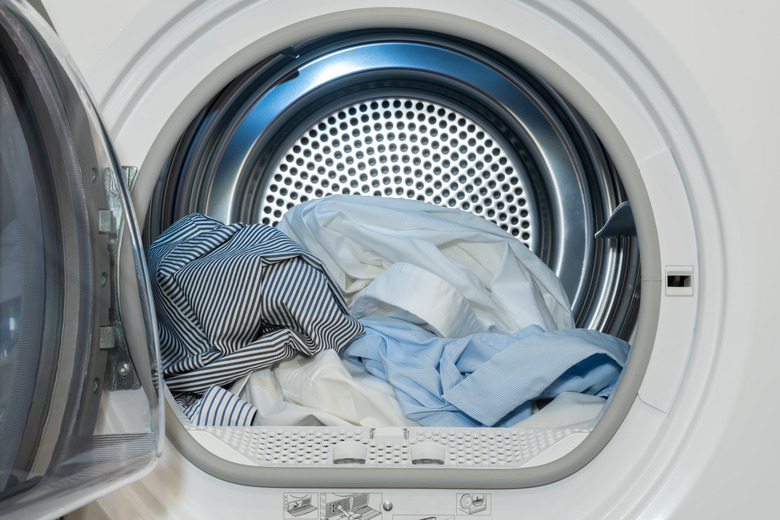Can Polyester Fabric Melt In The Dryer?
We may receive a commission on purchases made from links.
Learning about laundering is a rite of passage when you go out on your own: Sort the colors, hit "hot" or "cold," fold neatly, and iron when necessary — pretty basic stuff. But that hot-or-cold issue doesn't just apply to choosing wash-water temperature. It also matters when it's time to dry what you've washed, especially if it's a polyester garment. If the temperature is too hot while things are tumbling around, polyester fibers can take on a rippled look, and if it's extremely hot, the fabric can actually melt in the dryer, becoming hard and crunchy.
The Synthetic Nature of Polyester
The Synthetic Nature of Polyester
Because it's a plastic, polyester has long been a durable, easy-care fabric that resists shrinking, stretching, and wrinkling, becoming widely accepted early on by consumers who wanted easy-care clothing. Lower-priced polyester garments, such as women's wash-and-wear double-knit ensembles and men's leisure suits, reigned in the 1970s, but the fabric was uncomfortable. The synthetic nature of polyester was eventually viewed as very unhip, and all types of polyester, even those of higher quality, became the target of jokes.
Today's polyester has escaped the bad rap heaped upon the coarse, large-fiber product from a few decades ago. Different production techniques have made it possible to turn out softer fabrics, including luxurious microfiber. Polyester is now used in everything from high-fashion designs to top-selling outerwear and sportswear. When it comes to synthetic fabrics nowadays, polyester is a winner and is very popular, but it's still plastic — and plastic can melt.
Melt Prevention Is Easy
Melt Prevention Is Easy
Protecting your laundered polyester items from melting when you dry them is simple. You just need to pay attention to two things: the instructions on the care label attached to the clothing and the maintenance of your dryer.
The best way to avoid melting is to air-dry your polyester items, but it's unlikely that you have time for that, so follow the label, which will usually instruct you to tumble your 100 percent polyester garments on a low-heat, permanent-press cycle.
Accidentally adjusting your dryer to a hot setting can ripple the fibers or cause a degree of melting, but a dryer that overheats due to lint blockage or other mechanical failure can reach temperatures that are sure to ruin any polyester included in the load. Be sure to clean lint from the lint screen before or after each load. Vacuum the lint trap opening covered by the screen regularly and use a dryer-cleaning brush to clear lint out of the vent duct at least once a year.
If your dryer cabinet feels hot or if your clothes aren't drying as they should, this can indicate a blockage that should be remedied immediately. If you're unable to perform maintenance, call a service professional.
